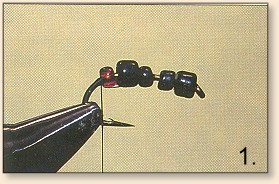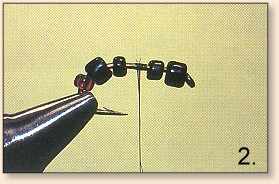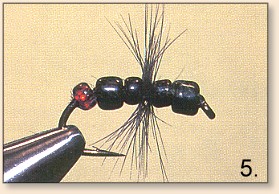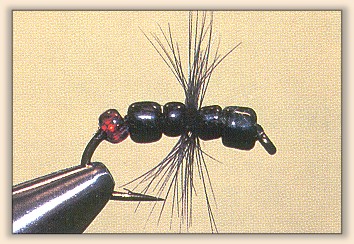I developed this fly in 1995 as a stealthy
terrestrial pattern for small turbulent creeks.
Its use expanded to beaver ponds where I used the
"what the heck, let's see if it works" approach.
The fish snarfed it up! In addition to brook trout,
rainbows have taken it too. Joe's Drowning Ant
illustrates how you can combine different sized beads
to create a tapered effect in conjunction with an
off-colored bead to accentuate the fly and create
a winning pattern. ~ Joe
Materials List: Joe's Drowning Ant
Hook: Daiichi 1530, sizes 10-12.
Thread: Black 6/0.
Body: Black bead, medium; two black beads, small;
and one black bead, medium.
Butt(optional): Scarlet (sl) bead, small.
Legs: Black neck hackle.
Tying Joe's Drowning Ant

1. Slide a medium size bead, two small beads, another
medium bead followed by a scarlet bead for the butt onto
the hook and place it in the vise. Tie in thread in
between the two small beads.

2. Advance the thread underneath the beads to the back of the
last bead, over and around the shank several times. Bring the
thread forward with two wraps between each bead until you are
between the two small beads again. Use your finger to hold the
beads in place as you wrap the thread.

3. Tie in a small neck hackle for the legs and advance
the thread forward slightly. Wrap the hackle several
times and secure with the thread. Trim excess hackle.

4. Advance thread forward to the eye of the hook wrapping
a couple of turns between the small and medium beads. Whip
finish thread to complete.

Credits:
Joe's Drowning Ant is one of many great patterns using
beads from Joe J. Warren's excellent book, Tying
Glass Bead Flies. Published by Frank Amato
Publications, ISBN: 1-57188-107-7.



